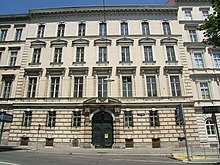Ferdinand Bloch-Bauer
Ferdinand Bloch-Bauer (born July 16, 1864 in Prague ; died November 13, 1945 in Zurich ; born Ferdinand Bloch ) was an Austro-Czech sugar manufacturer and art lover.
Youth and education
Ferdinand Bloch was born in 1864 as the son of the Jewish Prague sugar manufacturer David Bloch (1819-1892). He attended the commercial academy in Prague and then worked in the family business, which under his leadership expanded into a large European company.
Marriage with Adele Bauer and friendship with Klimt
In 1899, at the age of 35, Ferdinand Bloch met 18-year-old Adele Bauer , daughter of Moritz Bauer (1840–1905), General Director of the Vienna Bank Association and President of Orientbahnen. The two married in December of that year. Adele Bloch-Bauer suffered two stillbirths and her third child died two days after birth. When they got married, the couple decided to share the family name Bloch-Bauer.
Ferdinand Bloch-Bauer and his wife were respected personalities of the Viennese fin de siècle and the Austrian First Republic. In their premises at Schwindgasse 10 in Vienna's 4th district of Wieden and later at Elisabethstrasse 18 in the inner city , personalities from politics, business and culture like Karl Renner , Julius Tandler and Stefan Zweig , with whom the intellectually extremely active and the Adele Bloch-Bauer, who was inclined to social democracy , maintained intensive contacts.
The couple had a special relationship with the Austrian painter Gustav Klimt , for whom Adele often stood as a model and for whom Ferdinand supported financially. In the palace of the Bloch-Bauer family on Elisabethstrasse there were various paintings by Klimt such as Adele Bloch-Bauer I or Apfelbaum I , which had been commissioned by Ferdinand Bloch-Bauer.
In 1909 Bloch-Bauer acquired the " Jungfern Breschan " estate in Bohemia , where he housed his art collections in the Lower Castle. After the collapse of the Habsburg Monarchy , he opted for Czechoslovak citizenship in 1918/1819 and had this estate near Prague as his main residence.
Death of Adele Bloch-Bauer and expulsion
On January 24, 1925, Adele Bloch-Bauer died of meningitis and asked in her will that her husband bequeath her Klimt paintings to the Austrian State Gallery after his death . After 1945 the Republic of Austria based its claim to ownership on this passage and claimed that it contained a binding order. Bloch-Bauer stated in the probate proceedings for his deceased wife that the intended pictures had always been his property anyway (implicitly: his wife therefore could not dispose of them). During the Nazi era, important paintings came to the later Austrian Gallery Belvedere without Bloch-Bauer's permission during his lifetime.
Ferdinand Bloch-Bauer partially complied with his wife's request and gave away a few paintings even before his death. In 1927, the North Bohemian Trade Museum acquired a collection of paintings and drawings from Bloch. After the " Anschluss of Austria ", which Bloch-Bauer tried to avert with the support of Nazi opponents, he was driven out by the Nazis and had to leave all his assets behind. His property in Jungfern Breschan was confiscated after the Nazi occupation of the so-called “rest of Czechia” ; the Lower Castle was the seat of the Reich Protector for Bohemia and Moravia from 1939–1942 .
Ferdinand Bloch-Bauer fled first to Prague and later to Zurich, where he died impoverished on November 13, 1945. As requested in his will, his body was cremated in the Sihlfeld D crematorium . His urn was later buried in Vienna next to that of his wife in the family grave in the urn grove of the Simmering fire hall (Department MR, Group 47, Number 1G). The grave insists on the duration of the cemetery.
Legal dispute over the Klimt paintings
Bloch-Bauer bequeathed the pictures to the children of his brother Gustav Bloch in his will. Years of legal dispute followed between the heirs and the Republic of Austria over the paintings, which ended in 2006 with the restitution of the paintings confiscated by the Nazis to Maria Altmann , the last living niece, and her co-heirs.
Honor
- 2016 Street name Bloch-Bauer-Promenade , after Adele and Ferdinand Bloch-Bauer, in Vienna, Favoriten near the new main train station
literature
- Hubertus Czernin : The forgery. The Bloch-Bauer case. Volume 1. The Bloch-Bauer case and the work of Gustav Klimt. Volume 2. Volume III of the library of robbery . Czernin Verlag, Vienna 1999, ISBN 3-70760-000-9 .
- Tobias Natter, Gerbert Frodl (Ed.): Klimt and the women. Catalog of the Austrian Gallery Belvedere, Cologne / Vienna 2000.
Web links
- Literature by and about Ferdinand Bloch-Bauer in the catalog of the German National Library
- Detailed description of the lives of Ferdinand and Adele Bloch-Bauer ( memento from October 6, 2000 in the Internet Archive )
- The Bloch-Bauer case: documents on the legal dispute and numerous additional information (partly in English) ( Memento of August 30, 2000 in the Internet Archive )
Individual evidence
- ↑ Vienna names the street after Maria Lassnig. orf.at, April 8, 2016, accessed April 8, 2016.
- ^ Mailath: Maria-Lassnig-Straße decided. Press release City of Vienna, April 8, 2016, accessed April 8, 2016.
| personal data | |
|---|---|
| SURNAME | Bloch-Bauer, Ferdinand |
| ALTERNATIVE NAMES | Bloch, Ferdinand (maiden name) |
| BRIEF DESCRIPTION | Austro-Czech sugar manufacturer and art lover |
| DATE OF BIRTH | July 16, 1864 |
| PLACE OF BIRTH | Prague |
| DATE OF DEATH | November 13, 1945 |
| Place of death | Zurich |



